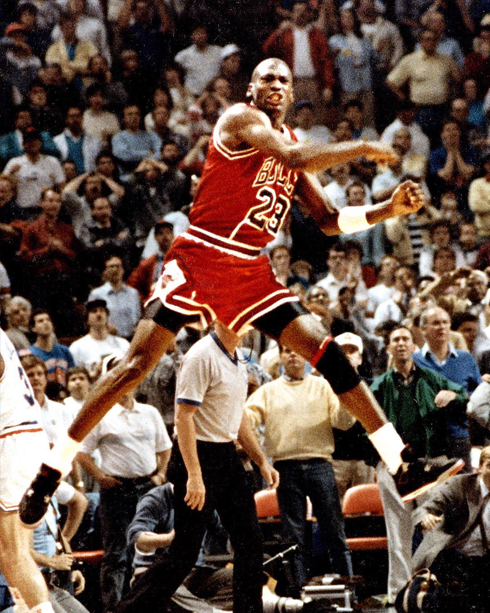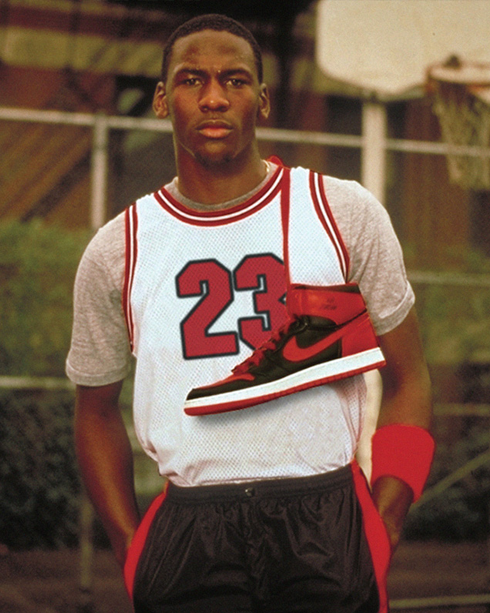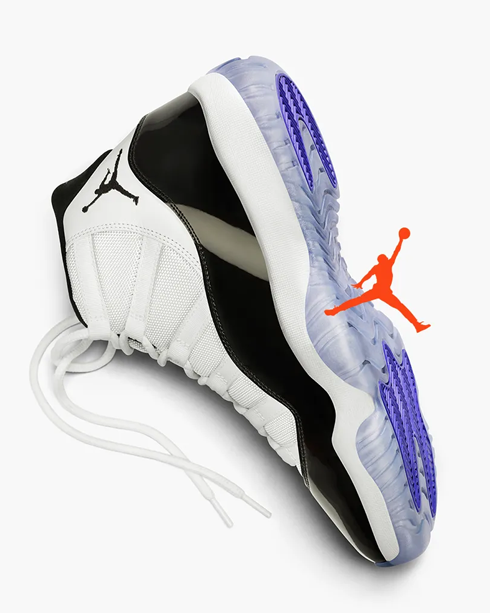Jordan
4
A historic sneaker and a cultural phenomenon.


A simple picture
On November 16th, 1988, Sports Illustrated released a special issue College Basketball Preview which, among other things, gave an overview of the ‘88-’89 season and introduced readers to some of the up-and-coming talent from around the country. A fascinating read for basketball fans, the magazine contained an unexpected sneak preview that would excite any sneaker enthusiast with an eye keen enough to notice it. Hidden towards the back, in a feature on Nike’s Sonny Vaccaro – the man who had arranged Michael Jordan’s first shoe deal with the brand four years earlier – was a picture of Phil Knight with a couple of interesting shoes. The Nike co-founder was sitting on a desk holding a white sneaker with black and gray highlights and the Nike Air logo on its heel, while beside him was a primarily black version of the same model with red and gray accents and the Jumpman logo clearly visible on its tongue. Several details made it obvious that this was not the Air Jordan 3, which was the latest in the signature line at the time, so it must have been the shoe’s successor – the Air Jordan 4. Whether or not this was an accidental leak is unclear, but what is certain is that the unassuming picture was merely the prelude to the amazing story of this most iconic of sneakers.

The All-Star Game
In the months that followed, there was little news about Jordan’s fourth signature sneaker as his loyal fans were kept waiting to see when it would be released. Then, MJ showed up to the February 1989 All-Star Game wearing a pair. Those who had seen the picture in Sports Illustrated would recognise the black colorway from Knight’s desk, its colors similar to those of the renowned Bred. Jordan put on a show during the match, pulling off some outrageous no-look passes and eventually top-scoring for team East with a series of trademark slam dunks that took him to 28 points. The fans were hooked and the shoe’s success ensured, but there were much bigger things to come for the Jordan 4.
A technological focus
Combined with the earlier picture, the AJ4’s appearance in the All-Star Game gave would-be buyers a chance to see some of its new features in action. While its predecessor had had a sleek style, this next iteration had a more technological feel to it, with notable additions like the unique over-moulded mesh and TPU lace locks standing out on its flanks. This was a deliberate move by the shoe’s designer, Tinker Hatfield, who had masterminded the successful evolution of the Jordan line with its third edition a year prior.

Breathability and durability
One of Nike’s most skilful creatives, Hatfield wanted to innovate again with the Jordan 4 and so moved away from the use of exotic materials that had defined its predecessor to focus more on practical components. In an early sketch dated 20th March, 1988, his fundamental desire to make a performance basketball trainer was clear as the words “breathability” and “durability” appeared prominently throughout. The former attribute was delivered through the urethane-coated mesh panels set into each side of the quarter and the lower part of the tongue, while the latter came from the structural triangle that supported the ankles and the rubber lateral cup wall that extended up from the outsole. The Black Cement colorway that Jordan wore during the All-Star Game also introduced synthetic Durabuck onto the upper – a material that was both more durable and more lightweight than traditional leather, making it ideal for a high-performance sports shoe.

The finer details
Other key features labeled on Hatfield’s sketch include the visible Air in the heel, which was backed up by an additional airbag in the forefoot, the flex cuts in the edges of the outsole and the distinctive variable-width lacing system created by the pieces of TPU over the top of the foot. These last features each held nine eyelets, giving the wearer a host of different lacing options, while their distinctive fan shape was echoed on the heel tab, which had embossed protrusions instead of holes to make it easily graspable when pulling the shoe on.

Jordan Flight
As with the Jordan 3, Hatfield was keen for Michael to be involved in designing the shoe. This meant that it reflected his on court persona and style, something which was evident in the bold Nike Air logo embossed onto the exaggerated heel panel, its lofty position acting as a reference to Jordan’s ability to defy gravity as he played. This extraordinary skill was also highlighted by a new tongue patch that added the word “Flight” in a stylised handwritten-style font below the instantly recognisable Jumpman silhouette.

Four stylish colorways
The first year of the Jordan 4 brought four colorways, each one matching the tones of the original Air Jordan 3s. As well as the two seen in Sports Illustrated, known as the White Cement and the Black Cement (or Bred), there was the Fire Red, with its mostly white outer and vivid red highlights, and the Military Blue, whose white and gray construction was accented with hints of suave azure tones. Each was popular in its own way, but Michael Jordan was soon to boost the fame and prosperity of the Air Jordan 4 once again in a remarkable, career-defining moment.

An unbelievable match
May 7th, 1989, is a day that will live long in the memories of Jordan and basketball fans around the world. It was the day of the deciding match between the Chicago Bulls and the Cleveland Cavaliers in the first round of a tightly contested playoff series. Both teams had traded blows in the first four games and arrived in Cleveland locked at 2-2. The fine margins separating the two became evident as the fifth game moved towards its dramatic conclusion, the lead going back and forth from the jump and changing hands several times in its final minute. In the dying moments, Chicago were just one point down but had only three seconds to make a score. Cool heads were required, and Bulls coach Doug Collins could be heard instructing his team to get the ball to Michael and get out of the way. They dutifully obliged, passing the ball to Jordan, who received it as he slipped away from two defenders with a mere two seconds remaining. The clock ticked down to a single second as he jumped in the air, poised to shoot. At that moment, Cavs player Craig Ehlo came flying towards him in an attempt to block, his last gasp action threatening to spoil the fairy-tale ending. In an incredible demonstration of composure, Jordan delayed his shot until Ehlo’s outstretched hand had drifted past him, seeming to hang in the air for a moment before releasing the ball towards the basket. The buzzer sounded, but it was too late – the ball was already dropping into the net. Jordan landed on his Jordan 4s before reeling away, leaping in the air and pumping his fist in triumph.

The Shot
Jordan’s magical buzzer-beater went down as one of the most clutch shots in the history of the sport, and the match one of its most exciting. In fact, it is so iconic that it has since come to be referred to simply as “The Shot”. His points tally of 44 secured his place as the highest scorer in the series, and he also ended the ‘88-’89 season as Scoring Champion for the third year in a row. Yet another outstanding return, it boosted the hype surrounding his new signature shoe, but it was that unforgettable clinch moment that drew the most fans to the design.
A turning point
While the Bulls failed to win the championship that year, they did reach the Eastern Conference Finals for the first time in Jordan’s career. However, it was the victory over the vaunted Cavaliers that was seen as a major turning point for Jordan and his teammates. In fact, many consider it this accomplishment that eventually led to their fabulous run of back-to-back titles in the early 90s. Meanwhile, as fans flocked to the shops eager to get their hands on the new AJ4, its stock was set to grow even further thanks to the shoe’s expansion into wider pop culture.

Becoming a cultural phenomenon
In the summer of 1989, Spike Lee released his new movie, Do the Right Thing, to heaps of critical acclaim and masses of commercial success. Set in a typical Brooklyn neighborhood, many of its characters sported the popular shoes of the time, including Buggin’ Out, who was involved in an iconic scene revolving around his Air Jordan 4s. In it, the outspoken character gets his shoes scuffed by a passerby, the camera focusing in on the black mark left on his otherwise clean white sneakers. Though only pictured for a moment, the model is clearly the Jordan 4 White Cement, its characteristic over-moulded mesh and TPU lace cages giving it away immediately. As the scene progresses, Buggin’ Out confronts the man, getting into an argument in which his friends tell him that his Jordans are ruined and he may as well throw them away. As well as being amusing and insightful (the altercation delves into wider societal issues including gentrification), the scene had a huge impact on sneaker culture, bringing Air Jordans and other shoes into a more mainstream conversation. Its influence was so important that Jordan Brand honored the moment in 2017 with a special version of the Air Jordan 4 White Cement that incorporated unique aspects of Buggin’ Out’s pair, such as the multi-colored lace adornment and even the black scuff mark left by the guy bumping into him.
A relatable character
The Jordan 4 was the first to have a global release, and its appearance in Do the Right Thing, which ended up garnering two Oscar nominations, certainly helped it achieve greater success around the world. However, another of Lee’s characters also played a part in the sneaker’s fame. Having already been involved in the marketing campaign for the Air Jordan 3 after first appearing in the 1986 movie She’s Gotta Have It, Spike Lee himself took up the role of the entertaining Mars Blackmon once again to appear in a series of adverts for the Air Jordan 4. The quirky Jordan enthusiast was the ideal foil for Michael in the ads, which were made in black and white to reflect the achromatic production of the movie. He was a normal, relatable guy who just loved Air Jordans and adored MJ. One of the most famous commercials promoting the AJ4 took advantage of this fact, showing that, while Blackmon could not achieve Jordan’s incredible level of skill, he could emulate the sports star by wearing his shoes. In it, Jordan is shown performing various extravagant slam dunks between shots of Blackmon explaining that you can buy the shoe, but you cannot do what Jordan does. It was played during the 1989 All-Star Game, and Lee went on to be involved in many more TV and print ads for Jordan Brand in the years that followed.

A hip hop favorite
Its appearance on the big screen also brought the Air Jordan 4 to the attention of popular hip hop stars and other music artists in the late 80s and early 90s. At the time, a young Jay-Z was pictured in a pair, and a famous image of Big Daddy Kane shows him relaxing in a limo with his AJ4-covered feet up on the seat in the center of the image. More recently, stars like Kid Cudi have been seen in the Black Cement, and rappers such as Curren$y, Lil Wayne and Wale have all referenced the Jordan 4 in their music, the last even mentioning Mars Blackmon on his 2011 track, Legendary, in which he sings, “Jordan 4 seated floorside sitting with Mars”. This line honors not only the shoe and the character, but also the sport of basketball and Spike Lee’s fondness for it, the director having become well-known for his courtside appearances at Knicks games, during which he was often pictured wearing Jordans.

Retro releases
These celebrity turns are a testament to the shoe’s enduring quality, which has seen it recreated and re-released on numerous occasions over the decades. Brought out around the time of Jordan’s second retirement in 1999, the very first retro releases were updated versions of the Bred and the White Cement, but these were accompanied by a whole host of new designs known as Retro+ colorways. The debut designs were the black and gray Oreo and the white and blue Columbia, while the white and chrome Bling followed a year later. Each of these new editions had perforated side panels in place of the mesh found on the original and Jumpman branding instead of the Nike Air logo on the heel. This initiated another fertile period for the Jordan 4, with dozens of colorways released in the time since, including popular iterations like the Military Black, the Black Cat and the Thunder & Lightning Pack.

Talented collaborators
Along with these dynamic colorways, the Air Jordan 4 has been involved in some of the most eye-catching collaborations in the history of the sneaker line. One of the earliest was with LA-based apparel brand Undefeated, who became the first sneaker boutique to produce an exclusive Jordan collaboration with their 2005 suede-covered design. Another notable partnership has been with Eminem, the pair producing a number of limited edition sneakers over the years. In the late 2010s, Jordan Brand teamed up with clothing company Levi’s to create a set of denim-covered AJ4s, and artist KAWS, who crafted a shoe clad in premium black suede with images of his distinctive toy etched into its outer. They also enlisted repeat-collaborator Travis Scott to design a blue and red sneaker that referenced the defunct Houston Oilers NFL team. This trend continued into the 2020s, with popular releases like Union LA’s Off-Noir and Guava Ice colorways, Off-White’s elegant Sail edition and A Ma Maniére’s sophisticated Violet Ore colorway. Much to the delight of skaters and Jordan fans alike, a long awaited collaboration with Nike SB finally arrived in 2023, its heritage look and skater-friendly features making it an especially popular release.

A Jordan mystique
Although it was released way back in 1989, the Air Jordan 4 is not only one of the most popular Jordans of all time, it is also one of the most prized of all sneakers. This is a result of its association with Michael’s historic series-winning shot and its position as an icon of popular culture, which was established by the Mars Blackmon TV ads and affirmed by its proliferation throughout the hip hop scene and its appearance in a hit movie. More than this, though, the Jordan 4 is simply a great sneaker. Tinker Hatfield has referred to it as “utilitarian, but still with a Jordan mystique” – a description which perfectly encompasses the practical functionality and stylish aesthetics that have made the sneaker as legendary as the player himself.


